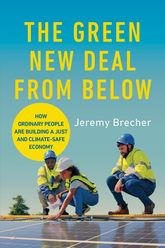originally published on Oxford Academic Online, accessible here: https://academic.oup.com/illinois-scholarship-online/book/60973?login=false
The Green New Deal from Below: How Ordinary People Are Building a Just and Climate-Safe Economy
Abstract
The Green New Deal is a visionary program to designed protect the earth’s climate while creating good jobs, reducing injustice, and eliminating poverty. Its core principle is to unite the necessity for climate protection with the goals of full employment and social justice. It is based on the framework of the New Deal, an agglomeration of programs launched during the 1930s to overcome the Great Depression and maintain a thriving society thereafter. The legacy of that program has continued to inspire Americans for almost a century. In 2018, that manifested in a resolution for a Green New Deal, a collaboration between activists and politicians that drew on the depth and breadth of New Deal programs as applied to climate change and the country’s economic struggles. The Green New Deal intrigued the public and gained wide support. However, it was greeted with heavy politically conservative and other fossil fuel–sponsored pushback. This eventually led to a pared-down endeavor and revised nomenclature in 2020, Build Back Better and the THRIVE Agenda. Though the new legislation promotes some climate protection, it also endorses false solutions, is not adequately funded to reach the necessary climate goals to maintain our world, and offers little to no protection for endangered communities.
- Front Matter
- Introduction: Shifting the Sense of What Is Possible (View chapter)
- Chapter 1: The Green New Deal in the Cities (View chapter)
- Chapter 2: The Green New Deal in the States (View chapter)
- Chapter 3: Unions Making a Green New Deal (View chapter)
- Chapter 4: Climate Justice from Below (View chapter)
- Chapter 5: Climate-Safe Energy Production (View chapter)
- Chapter 6: Negawatts (View chapter)
- Chapter 7: Fossil Fuel Phaseout (View chapter)
- Chapter 8: Transforming Transportation (View chapter)
- Chapter 9: Protecting Workers and Communities—On the Ground (View chapter)
- Chapter 10: Just Transition in the States: “There Ought to Be a Law!” (View chapter)
- Chapter 11: Green New Deal Jobs for the Future (View chapter)
- Conclusion (View chapter)
- The Green New Deal from Below and the Politics of the Possible
- Shifting the Sense of what is Possible
- Integrating Programs
- The Green New Deal Versus Neoliberalism
- From Below or from above—or Both?
- Planning
- Finding Resources
- Countering False Solutions
- Integrating Peoples
- The Green New Deal from Below as a Political Strategy
- The Anti–Green New Deal Forces
- Strategic Perspectives
- Strategic Objectives
- Strategy on the Ground
- Working on a World
- End Matter
- Notes
- Introduction
- Chapter 1. The Green New Deal in the Cities
- Chapter 2. The Green New Deal in the States
- Chapter 3. Unions Making a Green New Deal
- Chapter 4. Climate Justice from Below
- Chapter 5. Climate-Safe Energy Production
- Chapter 6. Negawatts
- Chapter 7. Fossil Fuel Phaseout
- Chapter 8. Transforming Transportation
- Chapter 9. Protecting Workers and Communities—On the Ground
- Chapter 10. Just Transition in the States
- Chapter 11. Green New Deal Jobs for the Future
- Conclusion
- Index
- About the Author
- Production Credits
- Notes
© University of Illinois Press 2024
